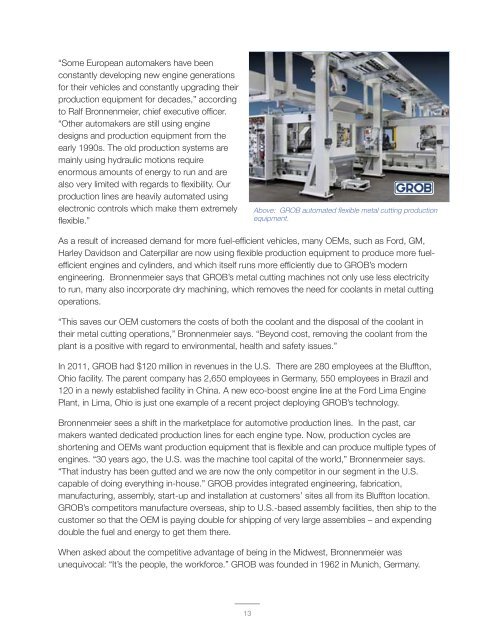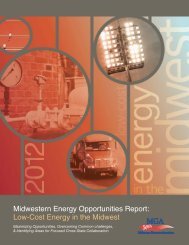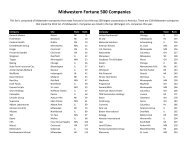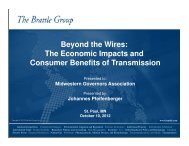Industrial Energy Productivity: Manufacturing Sector in the Midwest
Industrial Energy Productivity: Manufacturing Sector in the Midwest
Industrial Energy Productivity: Manufacturing Sector in the Midwest
You also want an ePaper? Increase the reach of your titles
YUMPU automatically turns print PDFs into web optimized ePapers that Google loves.
“Some European automakers have been<br />
constantly develop<strong>in</strong>g new eng<strong>in</strong>e generations<br />
for <strong>the</strong>ir vehicles and constantly upgrad<strong>in</strong>g <strong>the</strong>ir<br />
production equipment for decades,” accord<strong>in</strong>g<br />
to Ralf Bronnenmeier, chief executive officer.<br />
“O<strong>the</strong>r automakers are still us<strong>in</strong>g eng<strong>in</strong>e<br />
designs and production equipment from <strong>the</strong><br />
early 1990s. The old production systems are<br />
ma<strong>in</strong>ly us<strong>in</strong>g hydraulic motions require<br />
enormous amounts of energy to run and are<br />
also very limited with regards to flexibility. Our<br />
production l<strong>in</strong>es are heavily automated us<strong>in</strong>g<br />
electronic controls which make <strong>the</strong>m extremely<br />
flexible.”<br />
Above: GROB automated flexible metal cutt<strong>in</strong>g production<br />
equipment.<br />
As a result of <strong>in</strong>creased demand for more fuel-efficient vehicles, many OEMs, such as Ford, GM,<br />
Harley Davidson and Caterpillar are now us<strong>in</strong>g flexible production equipment to produce more fuelefficient<br />
eng<strong>in</strong>es and cyl<strong>in</strong>ders, and which itself runs more efficiently due to GROB’s modern<br />
eng<strong>in</strong>eer<strong>in</strong>g. Bronnenmeier says that GROB’s metal cutt<strong>in</strong>g mach<strong>in</strong>es not only use less electricity<br />
to run, many also <strong>in</strong>corporate dry mach<strong>in</strong><strong>in</strong>g, which removes <strong>the</strong> need for coolants <strong>in</strong> metal cutt<strong>in</strong>g<br />
operations.<br />
“This saves our OEM customers <strong>the</strong> costs of both <strong>the</strong> coolant and <strong>the</strong> disposal of <strong>the</strong> coolant <strong>in</strong><br />
<strong>the</strong>ir metal cutt<strong>in</strong>g operations,” Bronnenmeier says. “Beyond cost, remov<strong>in</strong>g <strong>the</strong> coolant from <strong>the</strong><br />
plant is a positive with regard to environmental, health and safety issues.”<br />
In 2011, GROB had $120 million <strong>in</strong> revenues <strong>in</strong> <strong>the</strong> U.S. There are 280 employees at <strong>the</strong> Bluffton,<br />
Ohio facility. The parent company has 2,650 employees <strong>in</strong> Germany, 550 employees <strong>in</strong> Brazil and<br />
120 <strong>in</strong> a newly established facility <strong>in</strong> Ch<strong>in</strong>a. A new eco-boost eng<strong>in</strong>e l<strong>in</strong>e at <strong>the</strong> Ford Lima Eng<strong>in</strong>e<br />
Plant, <strong>in</strong> Lima, Ohio is just one example of a recent project deploy<strong>in</strong>g GROB’s technology.<br />
Bronnenmeier sees a shift <strong>in</strong> <strong>the</strong> marketplace for automotive production l<strong>in</strong>es. In <strong>the</strong> past, car<br />
makers wanted dedicated production l<strong>in</strong>es for each eng<strong>in</strong>e type. Now, production cycles are<br />
shorten<strong>in</strong>g and OEMs want production equipment that is flexible and can produce multiple types of<br />
eng<strong>in</strong>es. “30 years ago, <strong>the</strong> U.S. was <strong>the</strong> mach<strong>in</strong>e tool capital of <strong>the</strong> world,” Bronnenmeier says.<br />
“That <strong>in</strong>dustry has been gutted and we are now <strong>the</strong> only competitor <strong>in</strong> our segment <strong>in</strong> <strong>the</strong> U.S.<br />
capable of do<strong>in</strong>g everyth<strong>in</strong>g <strong>in</strong>-house.” GROB provides <strong>in</strong>tegrated eng<strong>in</strong>eer<strong>in</strong>g, fabrication,<br />
manufactur<strong>in</strong>g, assembly, start-up and <strong>in</strong>stallation at customers’ sites all from its Bluffton location.<br />
GROB’s competitors manufacture overseas, ship to U.S.-based assembly facilities, <strong>the</strong>n ship to <strong>the</strong><br />
customer so that <strong>the</strong> OEM is pay<strong>in</strong>g double for shipp<strong>in</strong>g of very large assemblies – and expend<strong>in</strong>g<br />
double <strong>the</strong> fuel and energy to get <strong>the</strong>m <strong>the</strong>re.<br />
When asked about <strong>the</strong> competitive advantage of be<strong>in</strong>g <strong>in</strong> <strong>the</strong> <strong>Midwest</strong>, Bronnenmeier was<br />
unequivocal: “It’s <strong>the</strong> people, <strong>the</strong> workforce.” GROB was founded <strong>in</strong> 1962 <strong>in</strong> Munich, Germany.<br />
13







